Introduction
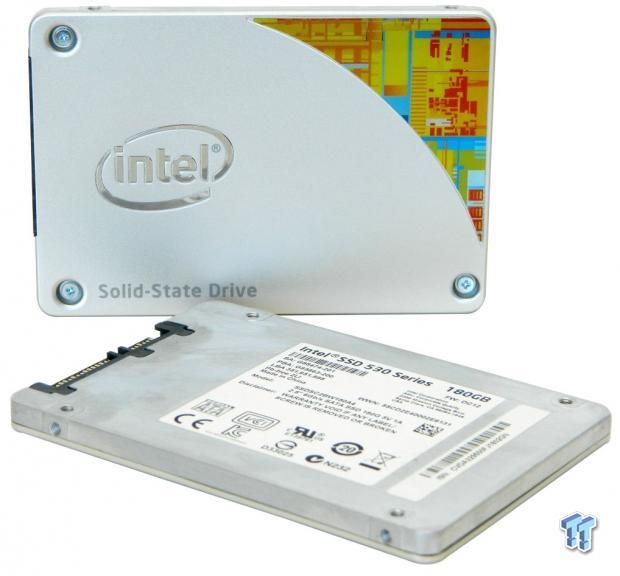
When you think Intel, two things come to mind almost immediately: performance and reliability. When the world's largest technology company puts their brand on a product, you know it is not just a run-of-the-mill piece of hardware. Intel is the leader when it comes to disruptive technologies like solid state storage.
I remember my first SSD; it was an Intel X-25M 80GB. The X-25M was really the world's first viable consumer SSD; in fact, the M stands for mainstream. The first time I booted my PC after installing an X-25M, it changed my whole perception of what performance really is. This single SSD made my four-drive Raptor array look like a complete joke.
Intel's X25M featured a 10-channel in-house controller and an in-house MLC NAND array. The X25M dominated the competition up to the point when a tiny company called SandForce launched their second-generation flash controller. SandForce's 2200 series 8-channel controller featuring compression technology provided superior performance to Intel's at a lower cost.
Intel shocked the world when it chose to collaborate with SandForce and launched their third generation SSD, the Intel 520, featuring SandForce's second-generation 2281 flash controller. This was so shocking because at the time SandForce 2200 series controllers were buggy and had already alienated many consumers from SandForce Products.
Intel, as Intel always does, touched it and turned it to gold. Intel designed their own exclusive firmware that was able to solve the infamous 2281 BSOD issue, and their 520 Series SSD became an instant success. At the time, the 520 was probably the fastest consumer SSD ever made. Intel's partnership with LSI SandForce continues to this day. Intel's latest collaboration with LSI Sandforce is their 530 Series mainstream SSD. Intel's 530 Series is not designed to deliver enthusiast class performance, but rather mainstream performance with unequaled Intel reliability.
The validation process Intel utilizes to ensure a high performing, reliable SSD is easily the world's most extensive. Heat, cold, humidity, shock, and even cosmic particle bombardment are all part of Intel's validation process. This extensive validation process produces SSDs with the industry's lowest annual failure rate (AFR).
Over the course of time, LSI SandForce's 2281 controller has become renowned for its reliable, predictable performance as well as its low power consumption, making it a no-brainer choice for a mainstream offering that can deliver the kind of reliability Intel demands of any product that bears their name.
Today, we are going to see how Intel's mainstream SSD performs in RAID 0. Intel's 530 in a 180GB capacity is their best-selling SSD, so it makes sense that we explore what a two-drive array of this capacity point has under the hood. The competition is fierce, so let us see what the battle looks like as we subject our 530 two-drive array to our ever-evolving testing regimen.
Specifications, Pricing and Availability, Drive Details & Test System Setup
Specifications, Pricing and Availability
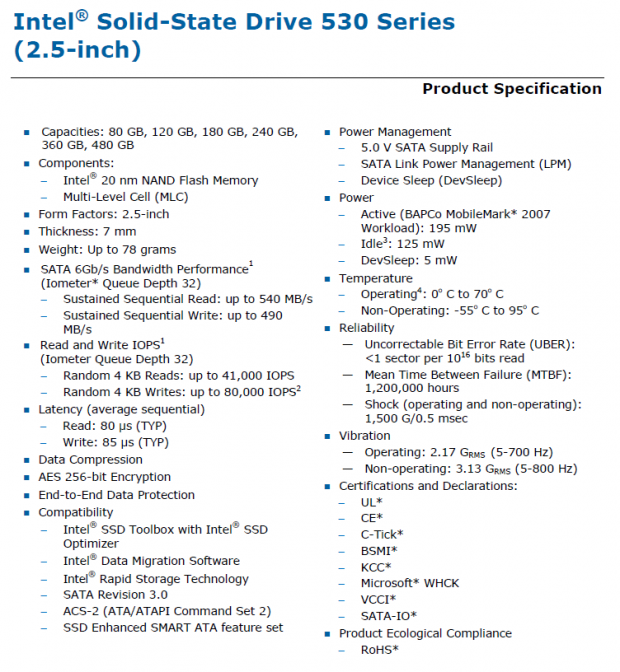
Intel's 530 Series 2.5-inch SATA III SSD is available in six capacity sizes: 80GB, 120GB, 180GB, 240GB, 360GB, and 480GB. The 180GB and 240GB variants will provide performance that is superior to the other capacity points in the series. Specifications list the 2.5-inch 530 Series SSDs as having a bandwidth performance of up to 540MB/s sequential reads and 490MB/s sequential writes. 4KB random read performance is listed at up to 41,000 IOPS, and 4 KB random write performance is listed at up to 80,000 IOPS. These performance figures are for compressible data.
We do not perform power testing for our RAID Reports, so we are not going to validate Intel's listed power usage. Intel lists power consumption at a very miserly 195 mW during workload, 125mW at idle, and 5mW in DevSleep.
When you purchase a retail packaged Intel SSD, you not only get a fine product, but you also get value added features like an accessory kit, Intel's SSD Toolbox, and Intel's Data Migration Software for easy maintenance and easy drive cloning. Our test drives came in bare OEM packaging, but the retail packaged 2.5-inch 530 ships with an accessory kit that includes SATA power and data cables, a sticker, a 7mm to 9.5mm adapter, software disk, and a 2.5-inch to 3.5-inch adapter. Intel warranties their 530 Series SSD for an industry leading five-years.
Since this is a RAID review, we are going to focus on performance rather than features. For a more in-depth look at the Intel 530's feature set, I will refer you to Chris Ramseyer's extensive review of Intel's 530 Series SSD.
Drive Details - Intel 530 Series 180GB SSD
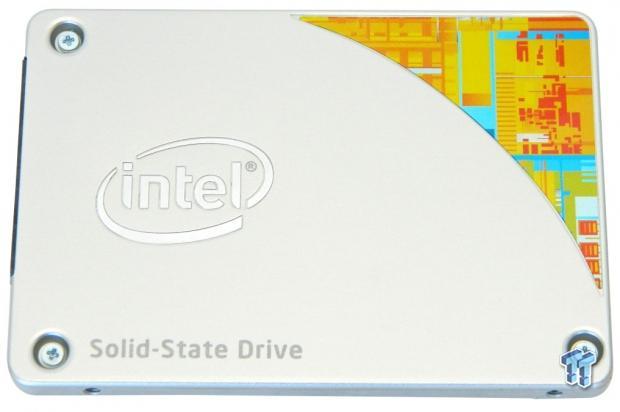
Our drives arrived bare, so we do not have anything to show you as far as packaging goes. The top of the drive's enclosure is formed from a piece of sheet aluminum, which is left natural in color. There is a chrome Intel logo stamped on the face and an attractive swoosh shaped sticker along the upper right corner. There are four screws that affix the top of the drive's enclosure to the bottom and sides of the enclosure. Three of the screws are visible, and the fourth screw is located under the drive's swoosh shaped sticker, providing evidence of tampering.
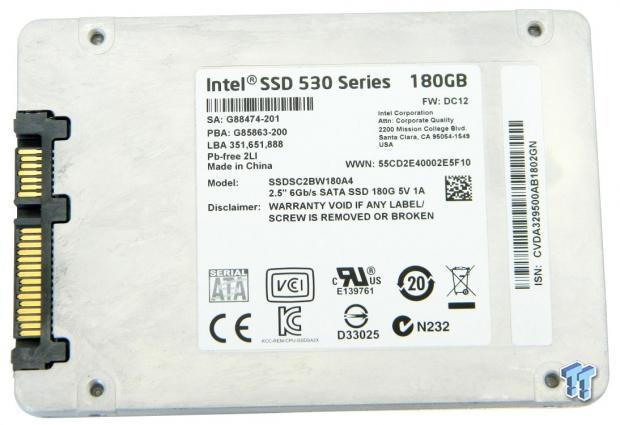
The bottom and sides of the drive's enclosure are formed from a single piece of cast aluminum. There is a manufacturer's sticker located on the bottom of the drive's enclosure. The sticker lists the drive's capacity, shipping firmware, model number, serial number, and various other relevant information.
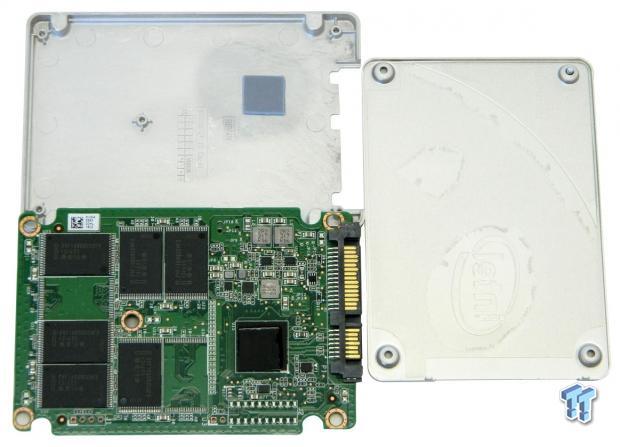
Here's what the drive looks like completely disassembled. On this side of the PCB, there are six Intel branded 20nm TSOP NAND Packages and an LSI SandForce 2281 controller. The LSI SandForce SF-2281 controller with this product has an Intel part number of BF29AS41BB0. A thermal pad makes contact with the drive's controller to wick heat into the cast aluminum portion of the enclosure.
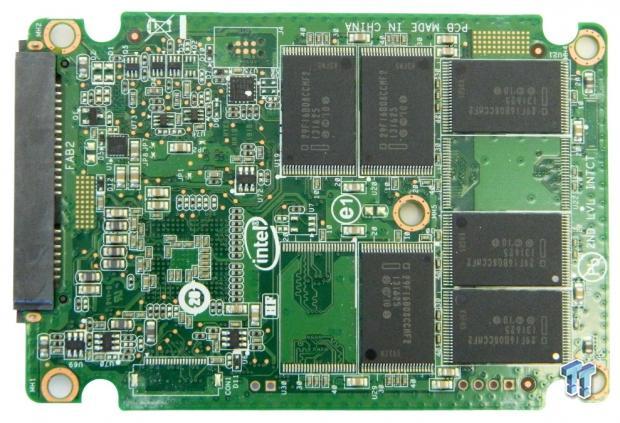
On the opposite side of the PCB, there are an additional six Intel branded 20nm TSOP NAND Packages.
Test System Setup
- Desktop Test System
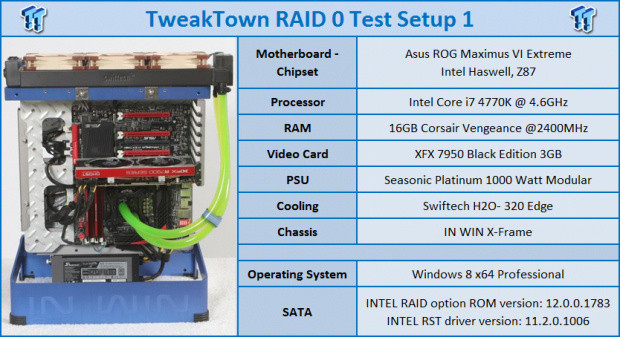
- Drive Properties
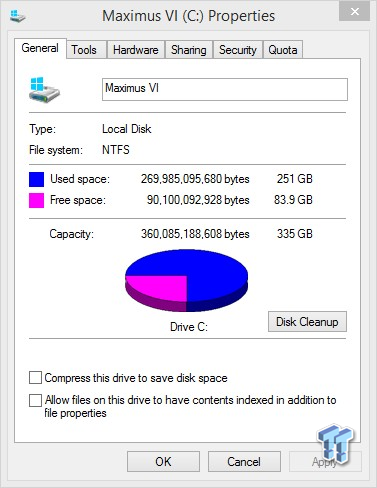
The majority of our testing will be done with our test drive/array as our boot volume. Our boot volume is 75 percent full for all OS Disk "C" drive testing to mimic a typical consumer OS volume implementation. We are using 64K stripes for all our arrays. Write caching is enabled.
All of our testing includes charting the performance of a single drive as well as a RAID 0 array of our test subjects. We are utilizing the Windows 8.1 64-bit OS for all of our testing.
PRICING: You can find the Intel 530 Series SSD for sale below. The prices listed are valid at the time of writing but can change at any time. Click the link to see the very latest pricing for the best deal.
United States: The Intel 530 Series SSD (180GB) retails for $145.85 at Amazon.
Canada: The Intel 530 Series SSD (180GB) retails for CDN$226.61 at Amazon Canada.
Australia: The Intel 530 Series SSD (120GB) retails for $141.99 AUD at Mighty Ape Australia.
New Zealand: The Intel 530 Series SSD (120GB) retails for $149.99 NZD at Mighty Ape NZ.
Synthetic Benchmarks - ATTO, Anvil Storage Utilities, CrystalDiskMark & AS SSD
ATTO
Version and / or Patch Used: 2.47
ATTO is a timeless benchmark used to provide manufacturers with data used for marketing storage products.
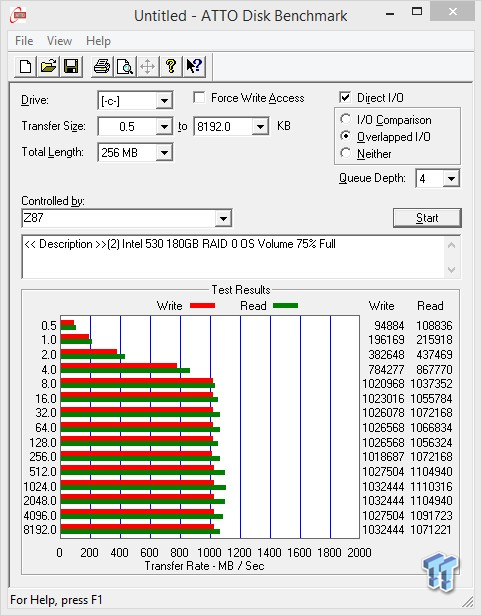
Transfers quickly ramp up, reaching full performance by 8k transfers. Read and write transfers are well balanced, strong, and consistent throughout, which is what we expect to see from a SandForce based array when the data is compressible.
Sequential Write
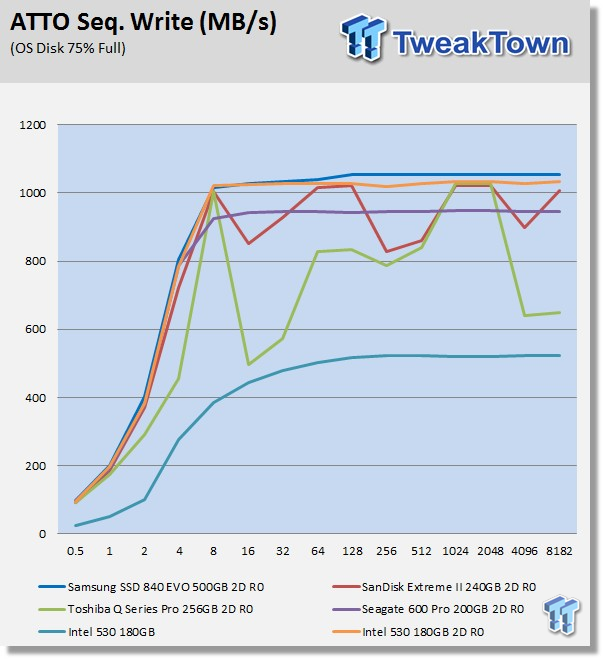
Write performance is second only to our EVO array.
Sequential Read
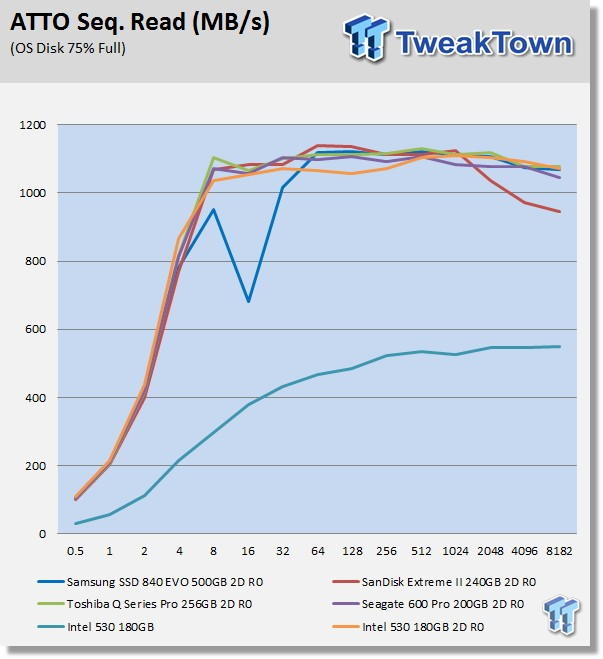
Sequential read ramps up very fast with our 530 array leading the pack at transfers up to 2k. By the end of the test, our 530 array is again running with the leaders on our chart despite being capacity handicapped. We should note that compressible data is where a SandForce based drive has no equal; however, most data comes in a compressed format, so with the exception of operating system data, this is an unrealistic portrayal of actual everyday performance you can expect from a SandForce based array.
Anvil Storage Utilities
Version and / or Patch Used: RC6
So what is Anvil Storage Utilities? First of all, it's a storage benchmark for SSDs and HDDs where you can check and monitor your performance. The Standard Storage Benchmark performs a series of tests, and you can run a full test; just the read or the write test; or you can run a single test, i.e. 4k QD16.
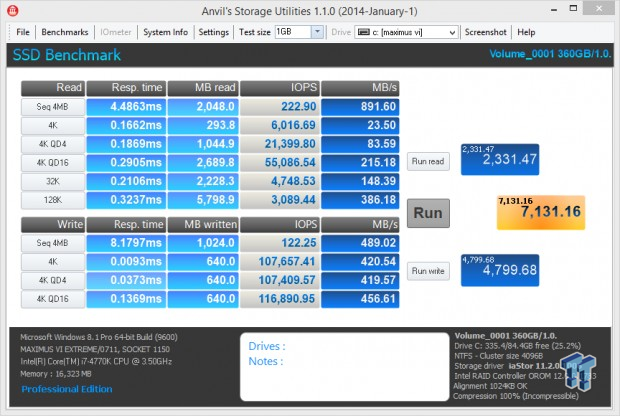
Incompressible data takes the legs out from under our SandForce array; that and our array's capacity handicap conspire to deliver poor performance.
Read IOPS through Queue Depth Scale
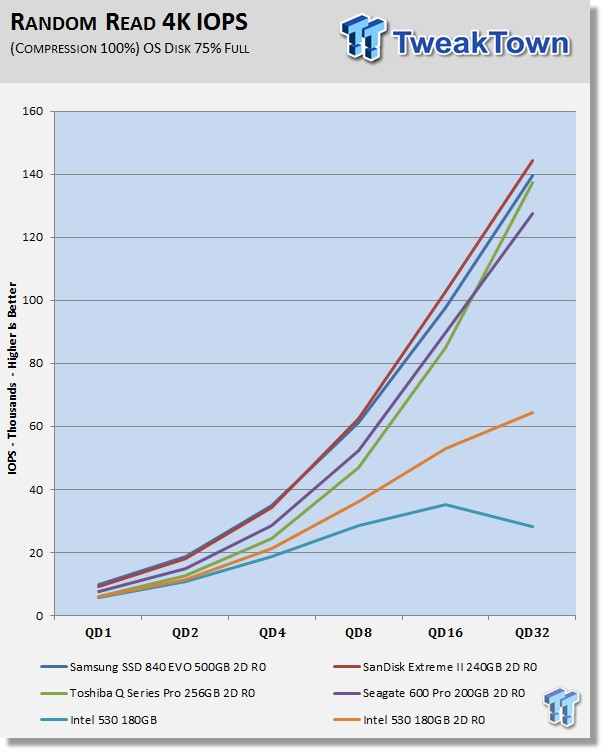
This is a clear demonstration of why the 530 is not advertised as an enthusiast class drive but rather a mainstream drive with an emphasis on reliability.
Write IOPS through Queue Scale
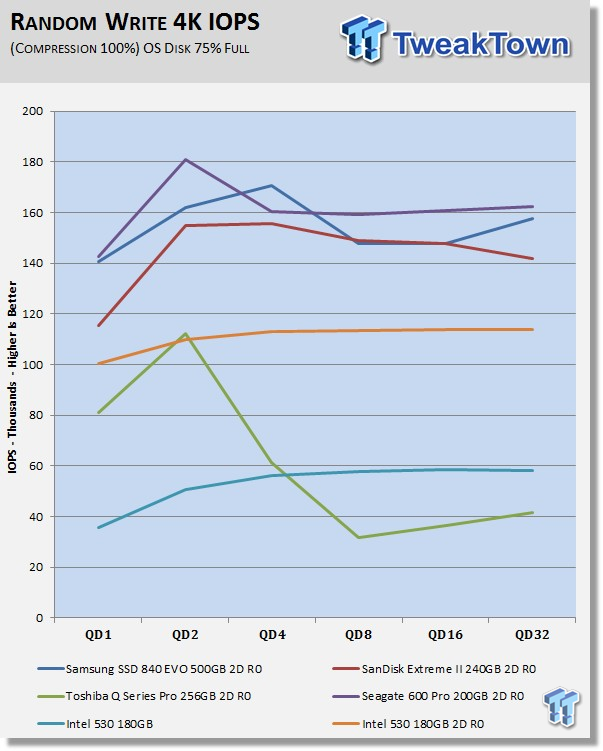
Keep in mind that synthetic testing, like Anvil, may not paint an accurate picture of a drive's true real-world performance. A perfect example of this is our Toshiba array that looks as if it is falling off a cliff when it is in reality one of the fastest arrays we have ever tested in a real-world scenario.
CrystalDiskMark
Version and / or Patch Used: 3.0 Technical Preview
CrystalDiskMark is disk benchmark software that allows us to benchmark 4k and 4k queue depths with accuracy.
Note: Crystal Disk Mark 3.0 Technical Preview was used for these tests since it offers the ability to measure native command queuing at 4 and 32.
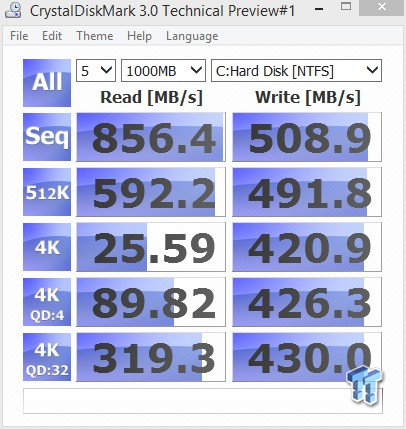
We see weak performance across the board, with the exception of 4k write performance.
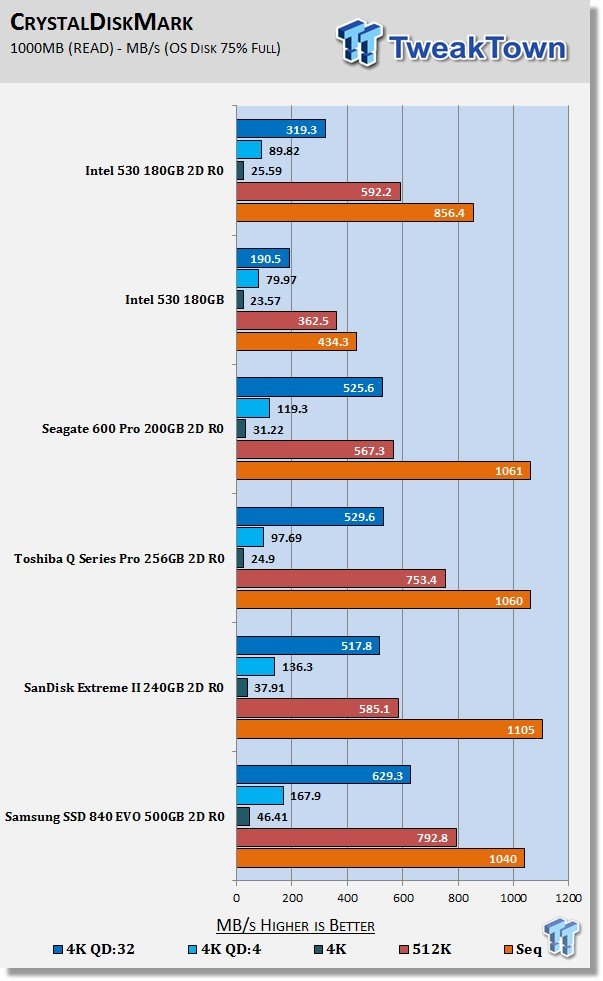
Incompressible read performance is mediocre. There's nothing good to report here.
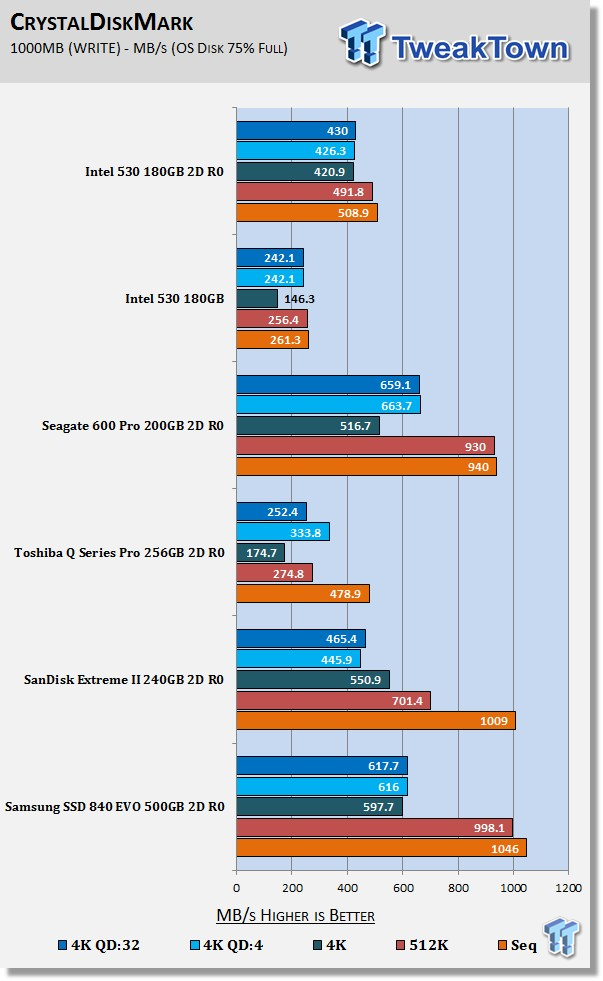
Incompressible data is crippling our 530 array. It is easy to see why compressible data numbers are advertised as opposed to incompressible; however, as mentioned, this testing may not be a good indicator of our array's true performance. Look at how abysmal our Toshiba array's performance is.
AS SSD
Version and / or Patch Used: 1.7.4739.38088
AS SSD determines the performance of Solid State Drives (SSD). The tool contains four synthetic as well as three practice tests. The synthetic tests are used to determine the sequential and random read and write performance of the SSD. These tests are carried out without the use of the operating system caches.
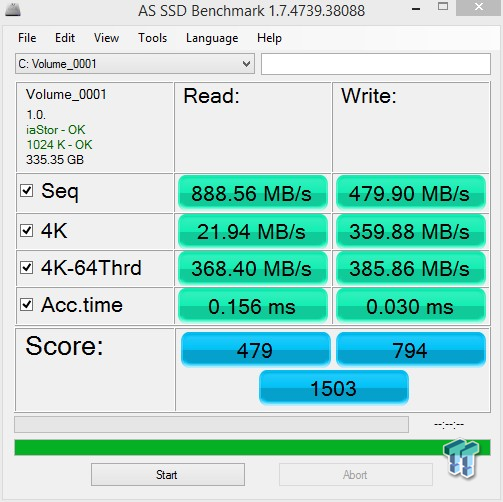
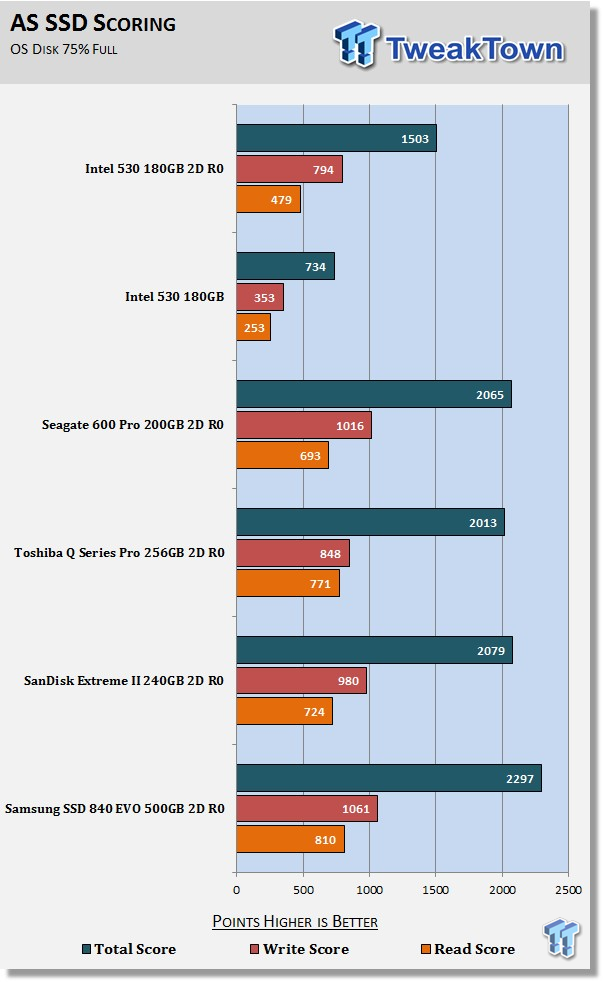
AS SSD can really bring a SandForce array to its knees and make drives like the EVO look unbeatable. As we move to our light usage model, we will get a clearer picture of what's really under the hood.
Benchmarks (Trace Based OS Volume) - PCMark Vantage, PCMark 7 & PCMark 8
Light Usage Model
We are going to categorize these tests as indicative of a light workload. If you utilize your computer for light workloads like browsing the web, checking emails, light gaming, and office related tasks, then this category of results is most relevant for your needs.
PCMark Vantage - Hard Disk Tests
Version and / or Patch Used: 1.2.0.0
The reason we like PCMark Vantage is because the recorded traces are played back without system stops. What we see is the raw performance of the drive. This allows us to see a marked difference between scoring that other trace-based benchmarks do not exhibit. An example of a marked difference in scoring on the same drive would be empty versus filled versus steady state.
We run Vantage three ways. The first run is with the OS drive/array 75 percent full to simulate a lightly used OS volume filled with data to an amount we feel is common for most users. The second run is with the OS volume written into a "Steady State" utilizing SNIA's guidelines (Rev 1.1). Steady state testing simulates a drive/array's performance similar to that of a drive/array that has been subjected to consumer workloads for extensive amounts of time. The third run is a Vantage HDD test with the test drive/array attached as an empty, lightly used secondary device.
OS Volume 75% Full - Lightly Used
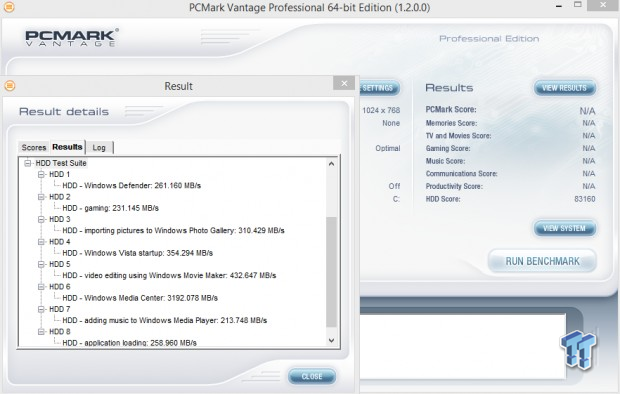
OS Volume 75% Full - Steady State
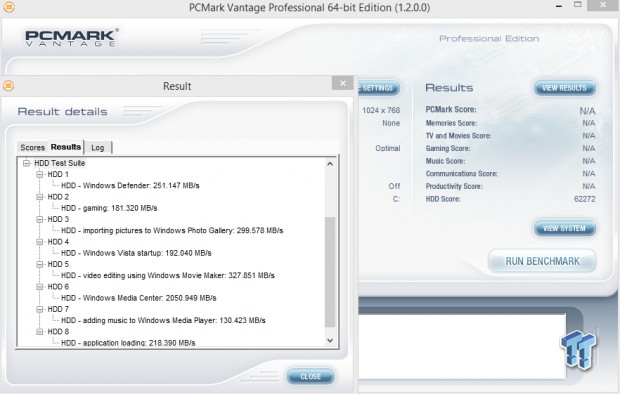
Secondary Volume Empty - Lightly Used
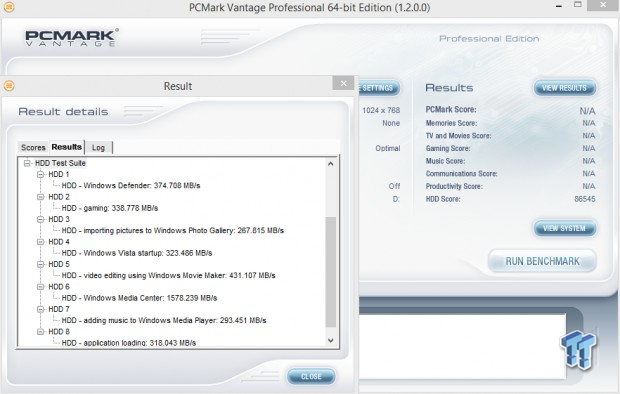
As you can see, there's a big difference between an empty drive/array, one that's 75 percent full/used, and one that's in a steady state.
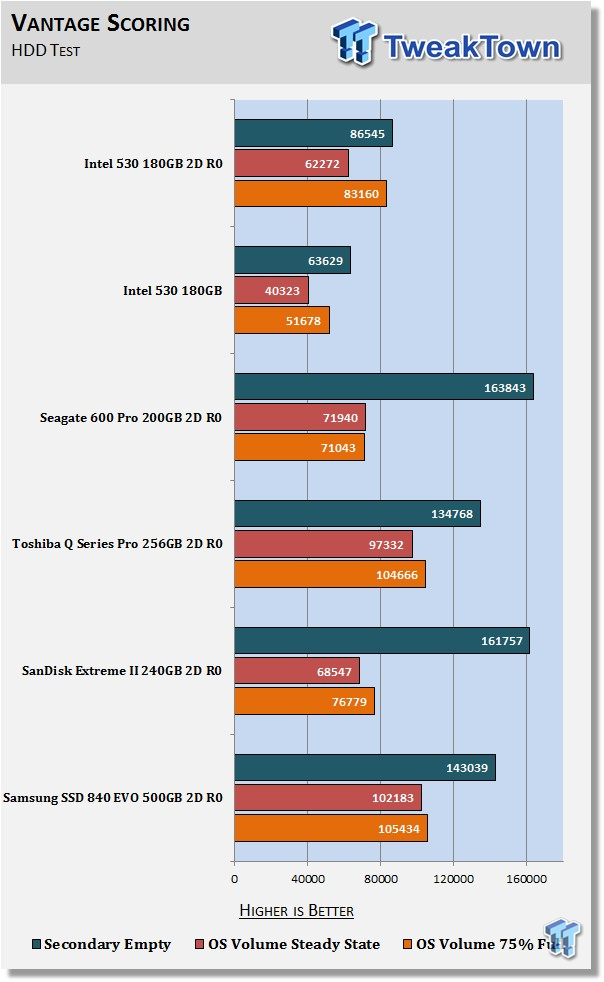
The important scores to pay attention to are "OS Volume Steady State" and "OS Volume 75% full." These two categories are most important because they are indicative of typical of consumer based user states.
When a drive/array is in a steady state, it means garbage collection is running at the same time it's reading/writing. There is a huge difference in performance between a single drive and a two-drive array.
Here we begin to see a turn-around. At 75 percent full with light usage, our 530 array is able to place third, beating out two of our top-performing arrays. Steady state scoring drops our 530 array into last place; however, a 62,000 point performance is exactly what we would expect to see from a mainstream class two-drive array.
PCMark 7 - System Storage
Version and / or Patch Used: 1.4.00
We will look to the Raw system storage scoring for RAID 0 evaluations because it's done without system stops and therefore allows us to see significant scoring differences between drives/arrays.
OS Volume 75% Full - Lightly Used
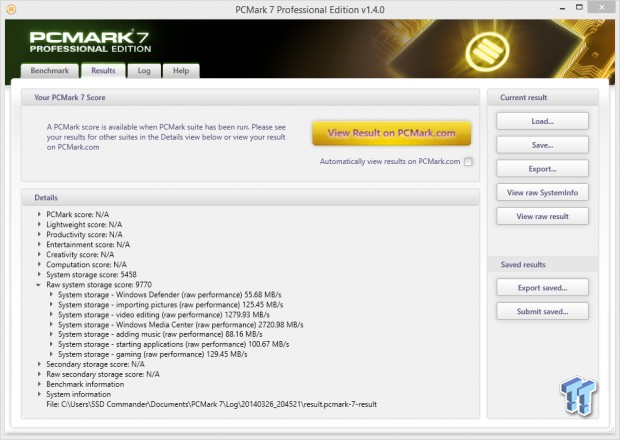
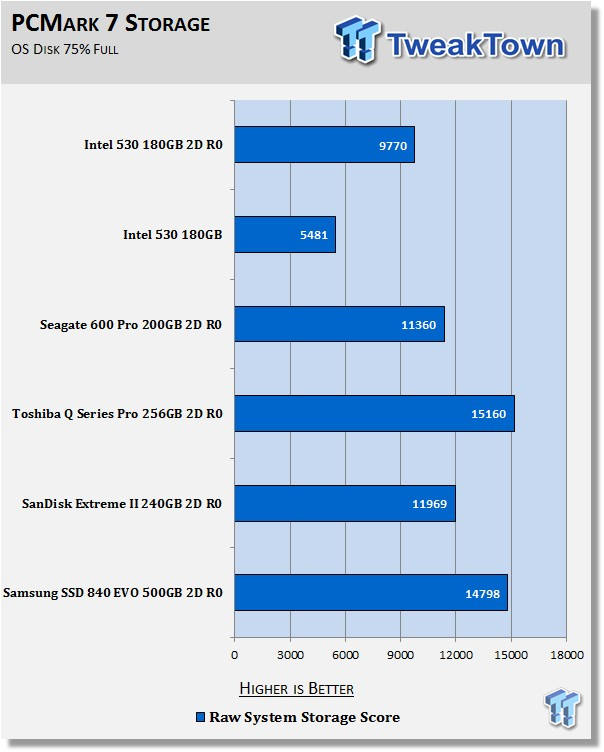
Like I said at the beginning, the competition is fierce, and the rest of the arrays on our chart are enthusiast class, which is a little unfair; however, they are the competition in a retail setting being priced virtually the same with the exception of Seagate's 600 Pro.
PCMark 8 - Storage Bandwidth
Version and / or Patch Used: 1.2.157
We use the PCMark 8 Storage benchmark to test the performance of SSDs, HDDs, and hybrid drives with traces recorded from Adobe Creative Suite, Microsoft Office, and a selection of popular games. You can test the system drive or any other recognized storage device, including local external drives. Unlike synthetic storage tests, the PCMark 8 Storage benchmark highlights real-world performance differences between storage devices.
OS Volume 75% Full - Lightly Used
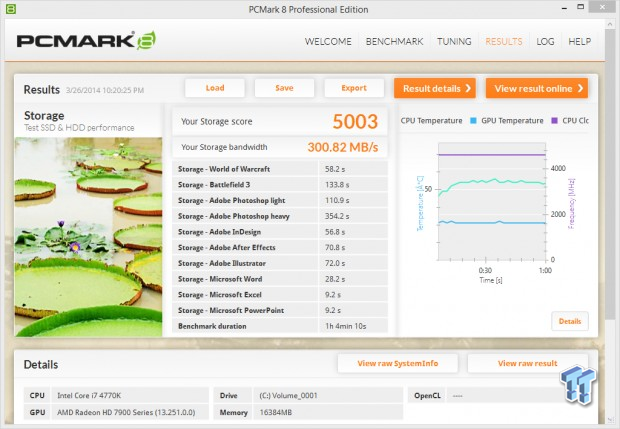
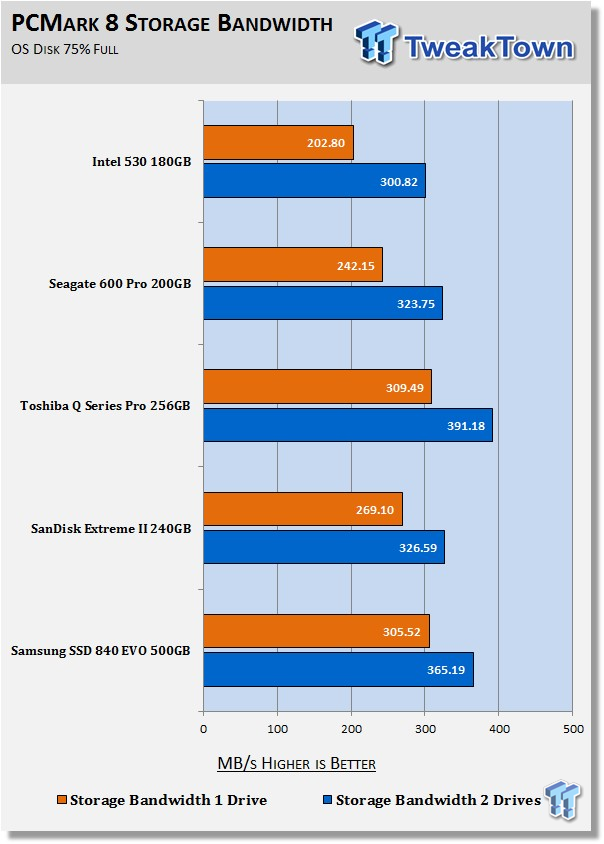
Here is something I have noticed: drives that utilize IMFT Flash scale better than those with Toshiba Flash. A 300MB/s storage bandwidth is the lowest of any array on our chart, but not by much. A single 530 is outclassed handily, but our 530 array scales better than any array on our chart, putting up good performance despite being capacity handicapped. This performance proves that a two-drive 530 array is capable of excellent performance, bordering on enthusiast class, when implemented in a light usage scenario.
Benchmarks (Secondary Volume) - Disk Response & Transfer Rates
Iometer - Disk Response
Version and / or Patch Used: 1.1.0
We use Iometer to measure disk response times. Disk response times are measured at an industry accepted standard of 4KkQD1 for both write and read. Each test is run twice for 30 seconds consecutively, with a 5 second ramp-up before each test. The drive/array is partitioned and attached as a secondary device for this testing.
Write Response
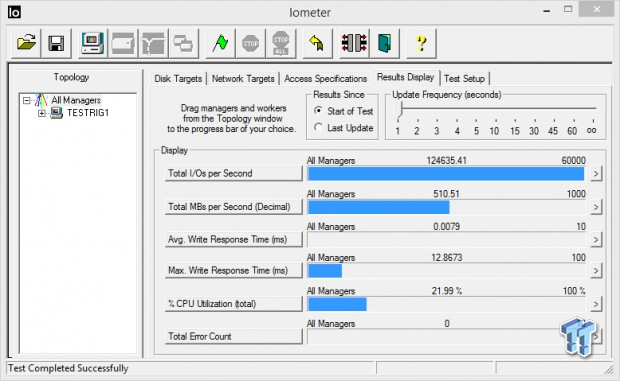
Read Response
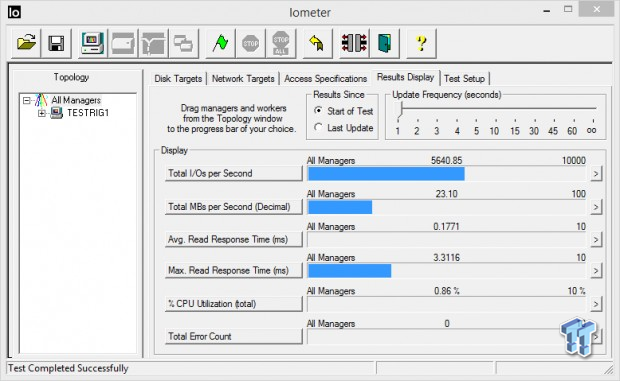
Average Disk Response
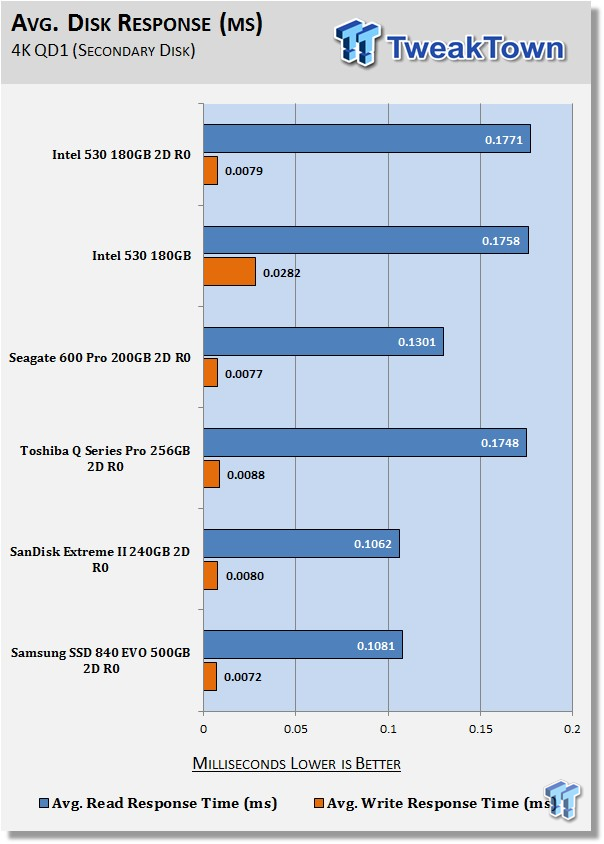
Write response times benefit most from RAID 0 because of write caching. There is a slight latency increase in read response times for an array versus a single drive. Write response times are excellent, bested only by our 600 Pro and EVO arrays. Our test is operating within our EVO array's emulated SLC "Turbo Write" layer, so keep in mind that an EVO array will only have this level of write latency as long as what you are transferring fits within this layer.
DiskBench - Directory Copy
Version and / or Patch Used: 2.6.2.0
We use DiskBench to time a 28.6GB block (9,882 files in 1,247 folders) of mostly incompressible random data as it's transferred from our OS array to our test drive/array. We then read from a 6GB zip file that's part of our 28.6GB data block to determine the test drive/array's read transfer rate. The system is restarted prior to the read test to clear any cached data, ensuring an accurate test result.
Write Transfer Rate
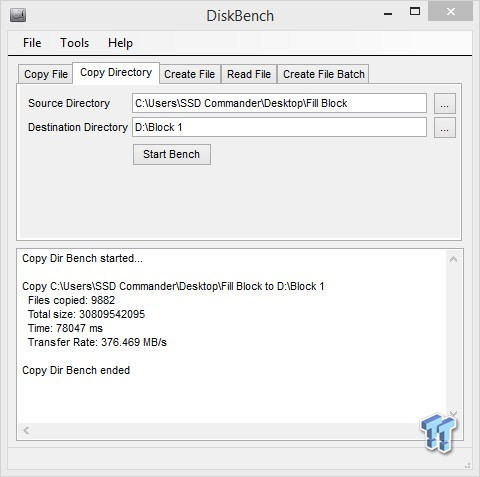
As expected, our 530 array's write transfer rate is not impressive.
Read Transfer Rate
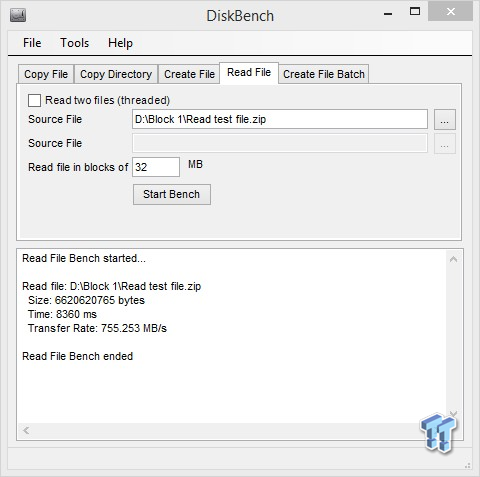
Read transfer rate is quite good, which is not surprising, because IMFT NAND scales very well.
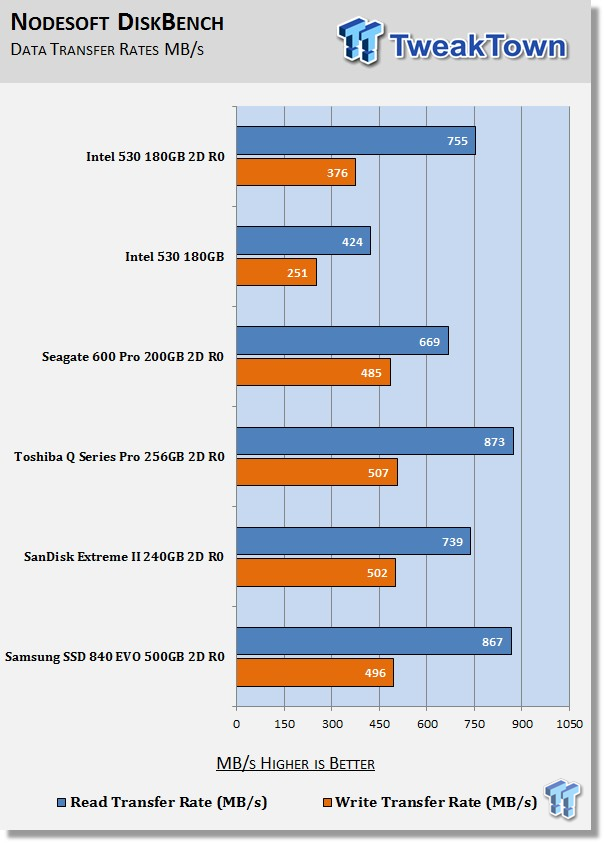
Once again, we see capacity limitation and incompressible data working against our 530 array's write transfer capabilities.
Benchmarks (Secondary Volume) - PCMark 8 Extended
Futuremark PCMark 8 Extended - Consistency Test
Heavy Usage Model
We consider PCMark 8's consistency test our heavy usage model test. This is the usage model most enthusiasts, heavy duty gamers, and professionals fall into. If you do a lot of gaming, audio/video processing, rendering, or have workloads of this nature, then this test will be most relevant to you.
PCMark 8 has built-in, command line executed storage testing. The PCMark 8 Consistency test measures the performance consistency and degradation tendency of a storage system.
The Storage test workloads are repeated. Between each repetition, the storage system is bombarded with a usage that causes degraded drive performance. In the first part of the test, the cycle continues until a steady degraded level of performance has been reached (Steady State).
In the second part, the recovery of the system is tested by allowing the system to idle and measuring the performance with long intervals (TRIM).
The test reports the performance level at the start, the degraded steady-state, the recovered state, and the number of iterations required to reach the degraded state and the recovered state.
We feel Futuremark's Consistency Test is the best test ever devised to show the true performance of solid state storage in a heavy usage scenario. This test takes on average 13 to 17 hours to complete and writes somewhere between 450GB and 7000GB of test data depending on the drives being tested. If you want to know what an SSD's performance is going to look like after a few months or years of heavy usage, this test will show you.
Here's a breakdown of Futuremark's Consistency Test:
Precondition phase:
1. Write to the drive sequentially through up to the reported capacity with random data.
2. Write the drive through a second time (to take care of overprovisioning).
Degradation phase:
1. Run writes of random size between 8*512 and 2048*512 bytes on random offsets for 10 minutes.
2. Run performance test (one pass only).
3. Repeat 1 and 2 for 8 times, and on each pass increase the duration of random writes by 5 minutes.
Steady state phase:
1. Run writes of random size between 8*512 and 2048*512 bytes on random offsets for 50 minutes.
2. Run performance test (one pass only).
3. Repeat 1 and 2 for 5 times.
Recovery phase:
1. Idle for 5 minutes.
2. Run performance test (one pass only).
3. Repeat 1 and 2 for 5 times.
Storage Bandwidth
PCMark 8's Consistency test provides a ton of data output that we can use to judge a drive's performance.
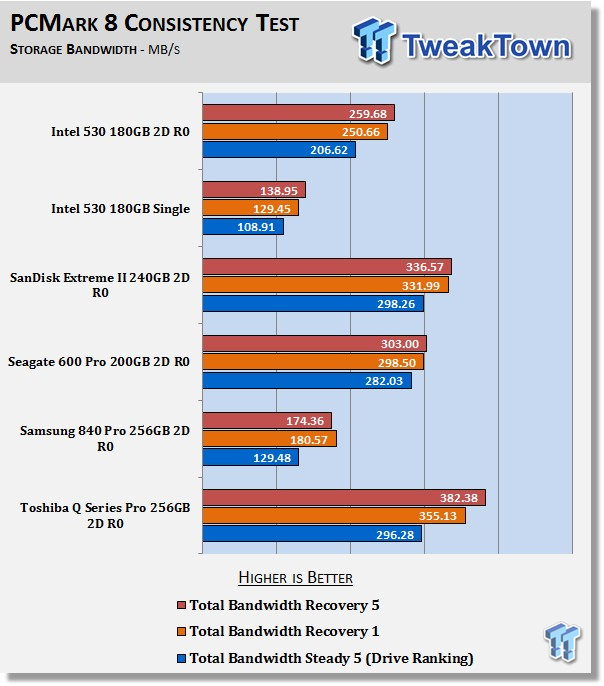
We consider steady state bandwidth (the blue bar) as our test that carries the most weight in ranking a drive's performance. The reason we consider steady state performance more important than TRIM is that when you are running a heavy-duty workload, TRIM will not be occurring while that workload is being executed. TRIM performance (the orange and red bars) is what we consider the second most important consideration when ranking a drive's performance. Trace-based consistency testing is where true high performing SSDs are separated from the rest of the pack.
Although our 530 array proved itself a worthy performer when subjected to our light usage model testing, it simply does not have good performance in heavy usage scenarios. Scaling is good--better than the other drives on our chart--but there just is not enough horsepower under the hood to be competitive with our top performing arrays. It does outperform our 840 Pro array, which comes as no surprise, because as we discovered in our previous two reviews, the 840 Pro chokes like a fish out of water when blasted with random data for an extended period of time.
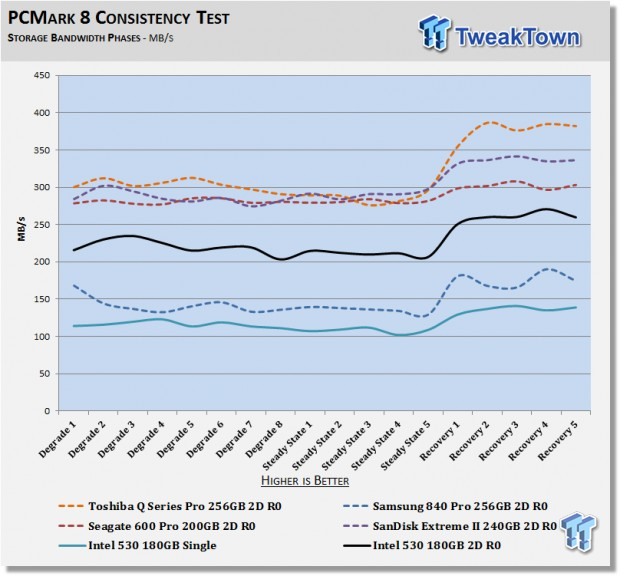
We chart our test subject's storage bandwidth as reported at each of the tests 18 trace iterations. This gives us a good visual perspective of how our test subjects perform as testing progresses.
Total Access Time (Latency)
Access time is the time delay or latency between a request to an electronic system and the access being completed or the requested data returned. Access time is how long it takes to get data back from the disk. We chart the total time the disk is accessed as reported at each of the test's 18 trace iterations.
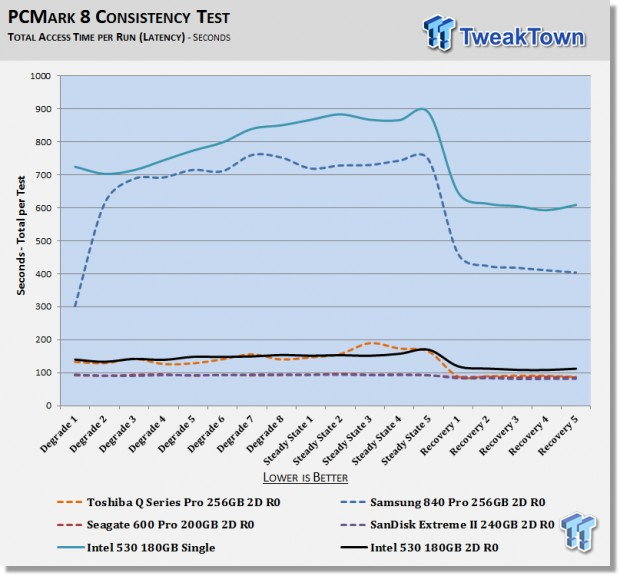
This is our clearest example of the benefits of RAID write caching. Latency improves on an order of magnitude in comparison to a single drive. This is not a function of scaling; this is a function of write caching that's not available for a single drive. Our 530 array does not have the storage bandwidth to be competitive, but it does have excellent overall latency.
Disk Busy Time
Disk Busy Time is how long the disk is busy working. We chart the total time the disk is working as reported at each of the tests 18 trace iterations.
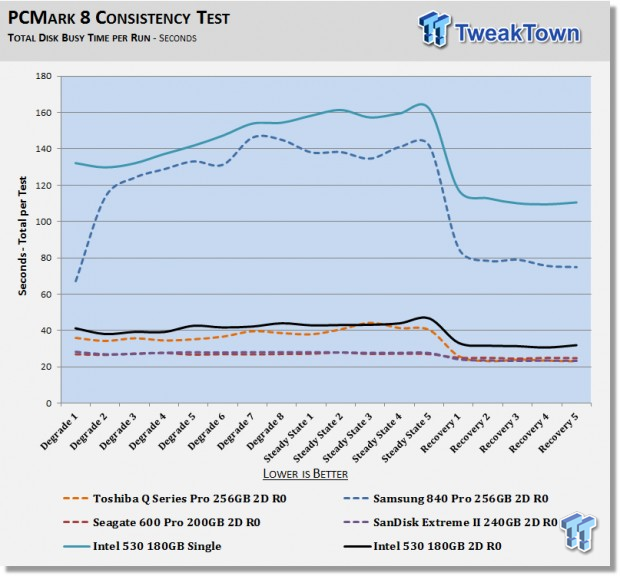
When latency is low, disk busy time is low as well. Our 530 array is able to spend approximately 3.5 times less time working than a single 530.
Data Written
We measure the total amount of random data that the drives are capable of writing during the degradation phases of the consistency test. The total combined time that degradation data is written to the drives is 470 minutes. This can be very telling. The better the drive can process a continuous stream of random data, the more data will be written.
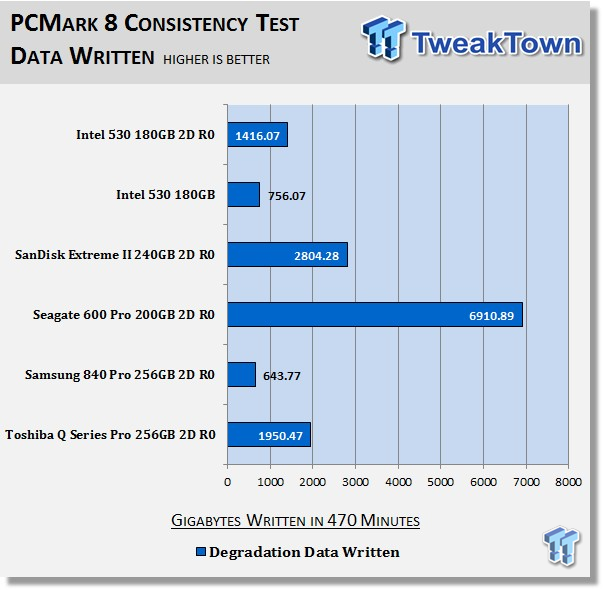
Low latency allows our 530 array to perform respectably, writing 1416 gigabytes of random data in 470 minutes. Our 600 Pro array lays waste to the competition due to its enterprise pedigree and heavy overprovisioning. Our 840 Pro array needs to be retired from our heavy usage model testing.
Final Thoughts
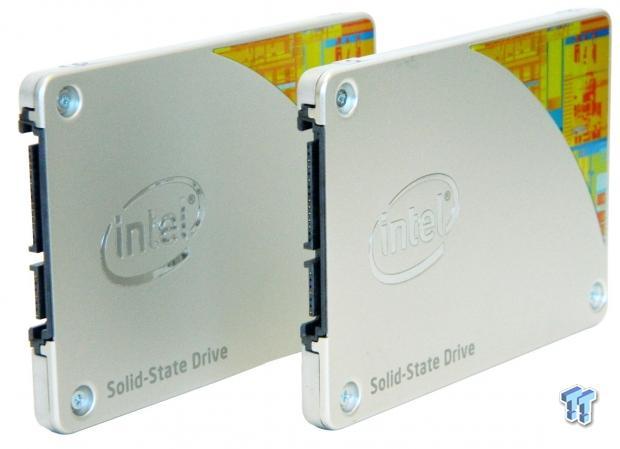
Solid state storage is the most important performance component found in a modern system today. Without it, you do not even have a performance system.
Even though second-generation LSI SandForce controllers are getting a little long in the tooth, they are still a viable option for mainstream SSDs. No longer the bully on the block, 2200 Series flash processors have assumed a new role that fits perfectly with the 530's targeted market, where consistent, reliable performance is more important than being the fastest. Intel designed the 530 to be a perfect Solid-State Solution for those venturing into the world of solid state performance for the very first time.
Intel SSDs have the lowest annual failure rate of any SSDs on the market, making them the perfect choice for the average consumer. The 530 in a retail package, with its 5-year warranty, provides the consumer everything they could possibly need to make the transition to the blazing fast world of solid state computing as simple as possible.
As a mainstream SSD, I can recommend you own an Intel 530 SSD; it will serve your needs well. You can just install it and forget about it. Knowing it's Intel and backed by Intel makes it one of the better choices you could make. In an enthusiast setting, the 530 comes up short. It simply doesn't have compelling performance. Putting the 530 in RAID does provide a significant boost because the drives scale so well, but in the end, there just is not enough there for today's enthusiast.
I would venture to say that most of our audience are Enthusiasts/Power Users, who are always-on the lookout for bleeding edge performance. After all, this is what we love about RAID 0 in the first place. Well, Intel has a purpose built SSD for us too. It is born from the data center, factory overclocked, and completely Intel powered. I'm speaking, of course, of Intel's newly launched Enthusiast Class 730 Series SSD, so stay tuned for our next RAID report where we showcase this exciting new SSD's RAID 0 performance.
Putting two or more drives together in RAID provides you with storage that takes performance to the next level and is something I recommend you try. Think of it as the SLI of storage. Once you go RAID, there's no going back!
PRICING: You can find the Intel 530 Series SSD for sale below. The prices listed are valid at the time of writing but can change at any time. Click the link to see the very latest pricing for the best deal.
United States: The Intel 530 Series SSD (180GB) retails for $145.85 at Amazon.
Canada: The Intel 530 Series SSD (180GB) retails for CDN$226.61 at Amazon Canada.
Australia: The Intel 530 Series SSD (120GB) retails for $141.99 AUD at Mighty Ape Australia.
New Zealand: The Intel 530 Series SSD (120GB) retails for $149.99 NZD at Mighty Ape NZ.


 United
States: Find other tech and computer products like this
over at
United
States: Find other tech and computer products like this
over at  United
Kingdom: Find other tech and computer products like this
over at
United
Kingdom: Find other tech and computer products like this
over at  Australia:
Find other tech and computer products like this over at
Australia:
Find other tech and computer products like this over at  Canada:
Find other tech and computer products like this over at
Canada:
Find other tech and computer products like this over at  Deutschland:
Finde andere Technik- und Computerprodukte wie dieses auf
Deutschland:
Finde andere Technik- und Computerprodukte wie dieses auf